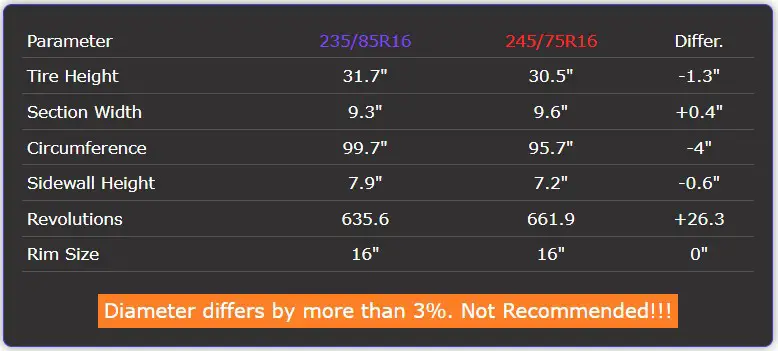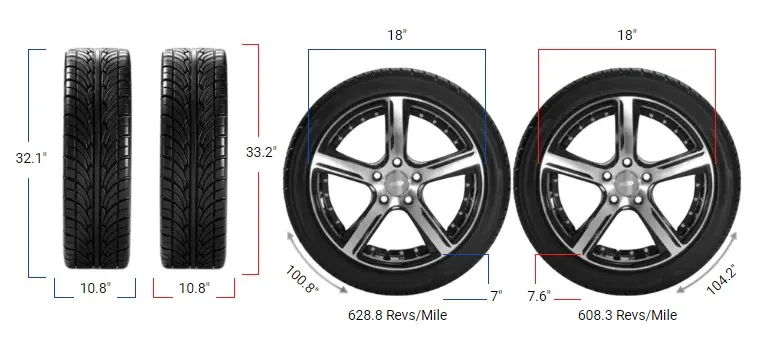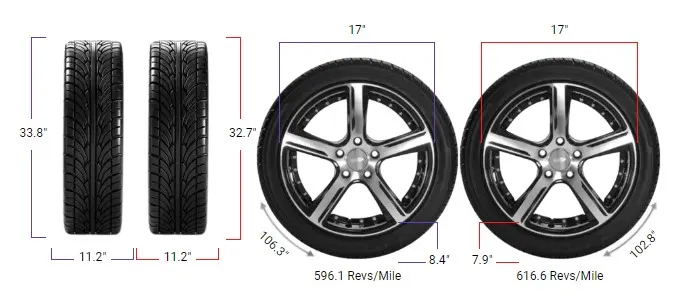Tire Size 235/85r16 vs 245/75r16
 Thinking about changing your tire size? Switching from 235/85r16 to 245/75r16 tires can impact your vehicle in several ways. Let’s dive into what this means for you.
Thinking about changing your tire size? Switching from 235/85r16 to 245/75r16 tires can impact your vehicle in several ways. Let’s dive into what this means for you.
- Increased tire width enhances grip on the road.
- Slightly reduced overall diameter may lower ground clearance.
- Lower sidewall height can improve handling responsiveness.
- More revolutions per mile can lead to a minor increase in speedometer readings.
- Wider tires may provide a more stable ride under load.
- Potentially better fuel efficiency due to reduced rolling resistance.
- Compatibility with different vehicles may vary based on clearance.
- Aesthetic appeal can improve with a wider stance.

Fitment Guide
Replacement tires should be within plus or minus 3% of the original tire’s overall diameter. The diameter difference here is -4%, exceeding the acceptable range. Therefore, the interchange is not recommended. Ignoring this may lead to issues like rubbing or clearance problems.
On-Road Impact
Changing tire sizes affects your vehicle’s behavior on paved roads. Here’s what to expect with this switch.

- Ride Comfort: The shorter sidewall of the 245/75r16 might result in a slightly firmer ride compared to the 235/85r16.
- Gas Mileage: A smaller diameter can cause the engine to run at higher RPMs at the same speed, potentially decreasing fuel efficiency.
- Speedometer Accuracy: Your speedometer may read faster than your actual speed due to the smaller tire size.
- Aesthetic Look: The wider 245/75r16 tires can give your vehicle a broader stance, altering its appearance.
Off-Road Impact
For off-road enthusiasts, tire size changes can significantly affect performance. Here’s how the switch impacts off-road driving.

- Ground Clearance: The 235/85r16 tires offer more ground clearance. Switching to 245/75r16 reduces clearance by about 1.26 inches, which might be critical on rough terrains.
- Durability & Wear: Wider tires like the 245/75r16 may provide better traction in certain conditions but could wear differently, especially under off-road stress.
- Rubbing Issues: The increased width might cause the tires to rub against the wheel wells if not properly accommodated.
235/85r16 vs 245/75r16
This table compares the key features of tire sizes 235/85R16 and 245/75R16.
| Feature | 235/85R16 | 245/75R16 | Difference |
|---|---|---|---|
| Diameter inches (mm) | 31.73 (805.9) | 30.47 (773.9) | -1.26 (-32) -4% |
| Width inches (mm) | 9.25 (235) | 9.65 (245) | 0.39 (10) 4.3% |
| Circumference inches (mm) | 99.68 (2531.81) | 95.72 (2431.28) | -3.96 (-100.53) -4% |
| Sidewall Height inches (mm) | 7.86 (199.75) | 7.23 (183.75) | -0.63 (-16) -8% |
| Revolutions per mile (km) | 635.65 (394.97) | 661.93 (411.31) | 26.28 (16.33) 4.1% |
| Speedo Reading | 20 mph (32.19 km/h) | 19.21 mph (30.91 km/h) | -0.79 mph |
Difference Between 235/85r16 and 245/75r16
The 235/85r16 tire is about 1.26 inches (32 mm) taller but 0.39 inches (10 mm) narrower than the 245/75r16. This means it has a larger diameter but a smaller width.
Can I Use 245/75r16 Instead of 235/85r16?
Using 245/75r16 tires instead of 235/85r16 is not recommended due to a diameter difference of around -4%, exceeding the acceptable 3% limit. This can affect speedometer accuracy and vehicle performance.
How Much Taller Is a 235/85r16 Tire Than a 245/75r16?
A 235/85r16 tire is approximately 1.26 inches (32 mm) taller than a 245/75r16 tire, making it about 4% larger in overall diameter.
How Much Wider Is a 245/75r16 Tire Than a 235/85r16?
A 245/75r16 tire is about 0.39 inches (10 mm) wider than a 235/85r16, which makes it approximately 4.3% wider in width.
Our Observation
Switching from 235/85r16 to 245/75r16 tires brings both benefits and drawbacks. On-road, you might notice a slightly firmer ride and a minor decrease in fuel efficiency.
The speedometer reading will be off by about 4%, meaning when it reads 20 mph, you’re actually going 19.21 mph. This difference is generally negligible for everyday driving but worth noting.
Off-road, the reduced ground clearance could impact your ability to tackle rough terrains and obstacles. While the wider tire offers better stability and may improve traction on some surfaces, the loss of over an inch in height might be significant for serious off-roading. For casual off-road use, this difference might be minimal.
In summary, if you prioritize on-road comfort and aesthetics, the 245/75r16 could be a reasonable option.
However, if off-road performance and ground clearance are essential, sticking with the 235/85r16 is advisable. Always consider how these changes align with your driving needs before making the switch.



